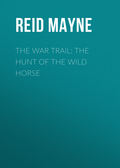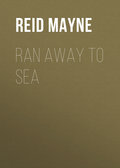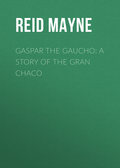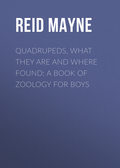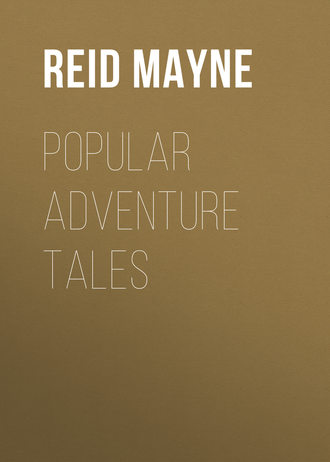
Майн Рид
Popular Adventure Tales
CHAPTER XII
THE CHAIN OF LAKES
Our young voyageurs now prepared to resume their journey. While Norman was engaged in building his canoe, with his assistant, François, the others had not been idle. Basil was, of course, the hunter of the party; and, in addition to the small game, such as hares, geese, and grouse, he had killed three caribou, of the large variety known as “woodland caribou.” These are a species of the reindeer of which I have more to say hereafter. Lucien had attended to the drying of their flesh; and there was enough of it still left, as our voyageurs believed, to supply their wants until they should reach Cumberland House, where they would, of course, procure a fresh stock of provisions. The skins of the caribou had also been scraped and dressed by Lucien – who understood the process well – and these, with the skin of the antelope, were sufficient to make a pair of hunting-shirts for Basil and Norman, who, it will be remembered, had lost theirs by cutting them up.
Next morning the canoe was launched upon the river – below the rapids – and the dried meat, with their other matters, snugly stowed in the stern. Then the young voyageurs got in, and, seating themselves in their places, seized hold of the paddles. The next moment the canoe shot out into the stream; and a triumphant cheer from the crew announced that they had recommenced their journey. They found to their delight that the little vessel behaved admirably – shooting through the water like an arrow, and leaking not water enough, as François expressed it, “to drown a mosquito.”
They had all taken their seats in the order which had been agreed upon for the day. Norman was “bowsman,” and, of course, sat in the bow. This, among the regular Canadian voyageurs, is esteemed the post of honour, and the bowsman is usually styled “Captain” by the rest of the crew. It is also the post that requires the greatest amount of skill on the part of its occupant, particularly where there are rapids or shoals to be avoided. The post of “steersman” is also one of honour and importance; and both steersman and bowsman receive higher wages than the other voyageurs who pass under the name of “middlemen.” The steersman sits in the stern, and that place was now occupied by Lucien, who had proved himself an excellent steersman. Basil and François were, of course, the “middlemen,” and plied the paddles.
This was the arrangement made for the day; but although on other days the programme was to be changed, so as to relieve Basil and François, on all occasions when there were rapids or other difficulties to be encountered they were to return to this order. Norman, of course, understood canoe navigation better than his Southern cousins; and therefore, by universal assent, he was acknowledged “the Captain,” and François always addressed him as such. Lucien's claim to the post of second honour was admitted to be just, as he had proved himself capable of filling it to the satisfaction of all. Marengo had no post, but lay quietly upon the buffalo skin between Lucien's legs, and listened to the conversation without joining in it, or in any way interfering in the working of the vessel.
In a few hours our voyageurs had passed through the low marshy country that lies around the mouth of the Red River, and the white expanse of the great Lake Winnipeg opened before them, stretching northward far beyond the range of their vision. Norman knew the lake, having crossed it before, but its aspect somewhat disappointed the Southern travellers. Instead of a vast dark lake which they had expected to see, they looked upon a whitish muddy sheet, that presented but few attractive points to the eye, either in the hue of its water or the scenery of its shores.
These, so far as they could see them, were low, and apparently marshy; and this is, in fact, the character of the southern shores of Winnipeg. On its east and north, however, the country is of a different character. There the geological formation is what is termed primitive. The rocks consist of granite, sienite, gneiss, &c.; and, as is always the case where such rocks are found, the country is hilly and rugged. On the western shores a secondary formation exists. This is stratified limestone– the same as that which forms the bed of many of the great prairies of America; and, indeed, the Lake Winnipeg lies between this secondary formation and the primitive, which bounds it on the east. Along its western shores extends the flat limestone country, partly wooded and partly prairie land, running from that point for hundreds of miles up to the very foot of the Rocky Mountains, where the primitive rocks again make their appearance in the rugged peaks of that stupendous chain.
Lake Winnipeg is nearly three hundred miles in length, but it is very narrow – being in its widest reach not over fifty miles, and in many places only fifteen miles from shore to shore. It trends nearly due north and south, leaning a little north-west and south-east, and receives many large rivers, as the Red, the Saskatchewan, and the Winnipeg. The waters of these are again carried out of it by other rivers that run from the lake, and empty into the Hudson's Bay. There is a belief among the hunters and voyageurs that this lake has its tides like the ocean. Such, however, is not the case. There is at times a rise and overflow of its waters, but it is not periodical, and is supposed to be occasioned by strong winds forcing the waters towards a particular shore.
Lake Winnipeg is remarkable, as being in the very centre of the North American continent, and may be called the centre of the canoe navigation. From this point it is possible to travel by water to Hudson's Bay on the north-east, to the Atlantic Ocean on the east, to the Gulf of Mexico on the south, to the Pacific on the west, and to the Polar Sea on the north and north-west. Considering that some of these distances are upwards of three thousand miles, it will be perceived that Lake Winnipeg holds a singular position upon the continent. All the routes mentioned can be made without any great “portage,” and even a choice of route is often to be had upon those different lines of communication.
These were points of information communicated by Norman as the canoe was paddled along the shore; for Norman, although troubling himself but little about the causes of things, possessed a good practical knowledge of things as they actually were. He was tolerably well acquainted with the routes, their portages, and distances. Some of them he had travelled over in company with his father, and of others he had heard the accounts given by the voyageurs, traders, and trappers. Norman knew that Lake Winnipeg was muddy – he did not care to inquire the cause. He knew that there was a hilly country on its eastern and a low level land on its western shores, but it never occurred to him to speculate on this geological difference.
It was the naturalist, Lucien, who threw out some hints on this part of the subject, and further added his opinion, that the lake came to be there in consequence of the wearing away of the rocks at the junction of the stratified with the primitive formation, thus creating an excavation in the surface, which in time became filled with water and formed the lake. This cause he also assigned for the existence of a remarkable “chain of lakes” that extends almost from the Arctic Sea to the frontiers of Canada. The most noted of these are Martin, Great Slave, Athabasca, Wollaston, Deer, Lake Winnipeg and the Lake of the Woods.
Lucien further informed his companions, that where primitive rocks form the surface of a country, that surface will be found to exhibit great diversity of aspect. There will be numerous lakes and swamps, rugged steep hills with deep valleys between, short streams with many falls and rapids. These are the characteristics of a primitive surface. On the other hand, where secondary rocks prevail the surface is usually a series of plains, often high, dry, and treeless, as is the case upon the great American prairies.
Upon such topics did Lucien instruct his companions, as they paddled their canoe around the edge of the lake. They had turned the head of their little vessel westward – as it was their design to keep along the western border of the lake until they should reach the mouth of the Saskatchewan. They kept at a short distance from the shore, usually steering from point to point, and in this way making their route as direct as possible. It would have been still more direct had they struck out into the open lake, and kept up its middle; but this would have been a dangerous course to pursue.
There are often high winds upon Lake Winnipeg, that spring up suddenly; and at such times the waves, if not mountains high, at least arrive at the height of houses. Among such billows the little craft would have been in danger of being swamped, and our voyageurs of going to the bottom. They, therefore, wisely resolved not to risk such an accident, but to “hug the shore,” though it made their voyage longer. Each night they would land at some convenient place, kindle their fire, cook their supper, and dry their canoe for the next day's journey.
According to this arrangement, a little before sunset of the first day they came to land and made their camp. The canoe was unloaded, carefully lifted out of the water, and then set bottom upward to drip and dry. A fire was kindled, some of the dry meat cooked, and all four sat down and began to eat, as only hungry travellers can.
CHAPTER XIII
WAPITI, WOLVES, AND WOLVERENE
The spot where our voyageurs had landed was at the bottom of a small bay. The country back from the lake was level and clear of timber. Here and there, nearer the shore, however, its surface was prettily interspersed with small clumps of willows, that formed little copse-like thickets of deep green. Beside one of these thickets, within a hundred yards of the beach, the fire had been kindled, on a spot of ground that commanded a view of the plain for miles back.
“Look yonder!” cried François, who had finished eating, and risen to his feet. “What are these, captain?” François pointed to some objects that appeared at a great distance off upon the plain.
The “captain” rose up, placed his hand so as to shade his eyes from the sun, and, after looking for a second or two in the direction indicated, replied to the other's question by simply saying —
“Wapiti.”
“I'm no wiser than before I asked the question,” said François. “Pray, enlighten me as to what a wapiti may be!”
“Why, red deer; or elk, if you like.”
“Oh! elk – now I understand you. I thought they were elk, but they're so far off I wasn't sure.”
Lucien at this moment rose up, and looking through a small telescope, which he carried, confirmed the statement of the “captain,” and pronounced it to be a herd of elk.
“Come, Luce,” demanded François, “tell us what you know of the elk. It will pass the time. Norman says it's no use going after them out there in the open ground, as they'd shy off before one could get within shot. You see there is not a bush within half-a-mile of them.”
“If we wait,” interrupted Norman, “I should not wonder but we may have them among the bushes before long. They appear to be grazing this way. I warrant you, they'll come to the lake to drink before nightfall.”
“Very well then: the philosopher can tell us all about them before that.”
Lucien, thus appealed to, began: —
“There are few animals that have so many names as this. It is called in different districts, or by different authors, elk, round-horned elk, American elk, stag, red deer, grey moose, le biche, wapiti and wewaskish.
“You may ask, Why so many names? I shall tell you. It is called 'elk' because it was supposed by the early colonists to be the same as the elk of Europe. Its name of 'grey moose' is a hunter appellation, to distinguish it from the real moose, which the same hunters know as the 'black moose.' 'Round-horned elk' is also a hunter name. 'Wewaskish,' or 'waskesse,' is an Indian name for the animal. 'Stag' comes from the European deer so called, because this species somewhat resembles the stag; and 'red deer' is a name used by the Hudson Bay traders. 'Le biche' is another synonyme of French authors.
“Of all these names I think that of 'wapiti,' which our cousin has given, the best. The names of 'elk,' 'stag,' and 'red deer,' lead to confusion, as there are other species to which they properly belong, all of which are entirely different from the wapiti. I believe that this last name is now used by the best-informed naturalists.
“In my opinion,” continued Lucien, “the wapiti is the noblest of all the deer kind. It possesses the fine form of the European stag, while it is nearly a third larger and stronger. It has all the grace of limb and motion that belongs to the common deer, while its towering horns give it a most majestic and imposing appearance. Its colour during the summer is of a reddish brown, hence the name red deer; but, indeed, the reddish tint upon the wapiti is deeper and richer than that of its European cousin.
“The wapiti, like other deer, brings forth its fawns in the spring. They are usually a male and female, for two is the number it produces. The males only have horns; and they must be several years old before the antlers become full and branching. They fall every year, but not until February or March, and then the new ones grow out in a month or six weeks. During the summer the horns remain soft and tender to the touch. They are covered at this time with a soft membrane, that looks like greyish velvet, and they are then said to be 'in the velvet.' There are nerves and blood-vessels running through this membrane, and a blow upon the horns at this season gives great pain to the animal. When the autumn arrives the velvet peels off, and they become as hard as bone.
“They would need to be, for this is the 'rutting' season, and the bucks fight furious battles with each other, clashing their horns together, as if they would break them to pieces. Very often a pair of bucks, while thus contending, 'lock' their antlers, and being unable to draw them apart, remain head to head, until both die with hunger, or fall a prey to the prowling wolves. This is true not only of the elk, but also of the reindeer, the moose, and many other species of deer. Hundreds of pairs of horns have been found thus 'locked,' and the solitary hunter has often surprised the deer in this unpleasant predicament.
“The wapiti utters a whistling sound, that can be heard far off, and often guides the hunter to the right spot. In the rutting season the bucks make other noises, which somewhat resemble the braying of an ass, and are equally disagreeable to listen to.
“The wapiti travel about in small herds, rarely exceeding fifty, but often of only six or seven. Where they are not much hunted they are easily approached, but otherwise they are shy enough. The bucks, when wounded and brought to bay, become dangerous assailants; much more so than those of the common deer. Hunters have sometimes escaped with difficulty from their horns and hoofs, with the latter of which they can inflict very severe blows. They are hunted in the same way as other deer; but the Indians capture many of them in the water, when they discover them crossing lakes or rivers. They are excellent swimmers, and can make their way over the arm of a lake or across the widest river.
“They feed upon grass, and sometimes on the young shoots of willows and poplar trees. They are especially fond of a species of wild rose which grows in the countries they frequent.
“The wapiti at one time ranged over a large part of the continent of North America. Its range is now restricted by the spread of the settlements. It is still found in most of the Northern parts of the United States, but only in remote mountainous districts and even there it is a rare animal. In Canada it is more common; and it roams across the continent to the shores of the Pacific. It it not an animal of the tropical countries, as it is not found in Mexico proper. On the other hand, wapiti do not go farther north than about the fifty-seventh parallel of latitude, and then they are not in their favourite habitat, which is properly the temperate zone.”
Lucien was interrupted by an exclamation from Basil, who stood up looking out upon the prairie. They all saw that he had been observing the wapiti.
“What is it?” cried they.
“Look yonder!” replied Basil, pointing in the direction of the herd. “Something disturbs them. Give me your glass, Luce.”
Lucien handed the telescope to his brother, who, drawing it to the proper focus, pointed it towards the deer. The rest watched them, with the naked eye. They could see that there was some trouble among the animals. There were only six in the herd, and even at the distance our voyageurs could tell that they were all bucks, for it was the season when the does secrete themselves in the woods and thickets to bring forth their young. They were running to and fro upon the prairie, and doubling about as if playing, or rather as if some creature was chasing them. With the naked eye, however, nothing could be seen upon the ground but the bucks themselves, and all the others looked to Basil, who held the glass, for an explanation of their odd manœuvres.
“There are wolves at them,” said Basil, after regarding them for a second or two.
“That's odd,” rejoined Norman. “Wolves don't often attack full-grown wapiti, except when wounded or crippled somehow. They must be precious hungry. What sort of wolves are they?”
To you, boy reader, this question may seem strange. You, perhaps, think that a wolf is a wolf, and there is but one kind. Such, however, is not the exact truth. In America there are two distinct species or wolves, and of these two species there are many varieties, which differ so much in colour and other respects, that some authors have classed them as so many distinct species instead of considering them mere varieties. Whether they may be species or not is still a question among naturalists; but certain it is that two well-defined species do exist, which differ in size, form, colour, and habits.
These are the large or common wolf, and the barking or prairie wolf. The first species is the American representative of the common wolf of Europe; and although an animal of similar nature and habits, it differs very much from the latter in form and appearance. It is, therefore, not the same, as hitherto supposed. This American wolf is found in greater or less numbers throughout the whole continent; but in the Northern regions it is very common, and is seen in at least five different varieties, known by the characteristic names of black, pied, white, dusky, and grey wolves. Of these the grey is the most numerous kind; but as I shall have occasion to speak of the large wolves hearafter, I shall say no more of them at present, but direct your attention to the second and very different species, the prairie wolves.
These are a full third smaller than the common kind. They are swifter, and go in larger packs. They bring forth their young in burrows on the open plain, and not among the woods, like the other species. They are the most cunning of American animals, not excepting their kindred the foxes. They cannot be trapped by any contrivance, but by singular manœuvres often themselves decoy the over-curious antelope to approach too near them. When a gun is fired upon the prairies they may be seen starting up on all sides, and running for the spot in hopes of coming in for a share of the game. Should an animal – deer, antelope, or buffalo – be wounded, and escape the hunter, it is not likely to escape them also. They will set after it, and run it down if the wound has been a mortal one.
On the other hand, if the wound has been only slight, and is not likely in the end to cripple the animal, the wolves will not stir from – the spot. This extraordinary sagacity often tells the hunter whether it is worth his while to follow the game he has shot at; but in any case he is likely to arrive late, if the wolves set out before him, as a dozen of them will devour the largest deer in a few minutes' time. The prairie wolves as well as the others follow the herds of buffaloes, and attack the gravid cows and calves when separated from the rest. Frequently they sustain a contest with the bulls, when the latter are old or wounded, but on such occasions many of them get killed before the old bull becomes their prey.
They resemble the common grey wolf in colour, but there are varieties in this respect, though not so great as among the larger species. Their voice is entirely different, and consists of three distinct barks, ending in a prolonged howl. Hence the specific and usual name “barking wolf.” They are found only in the Western or prairie half of the continent, and thence west to the Pacific. Their Northern range is limited to the fifty-fifth parallel of latitude – but they are met with southward throughout Mexico, where they are common enough, and known by the name of “coyoté.”
Their skins are an article of trade with the Hudson's Bay Company. The fur is of about the same quality with that of other wolves, and consists of long hairs, with a thick wool at the base. In commerce they are termed “cased wolves,” because their skins, on being removed, are not split open as with the large wolf-skins, but are stript off after the manner of rabbits, and then turned inside out, or “cased,” as it is termed.
“Prairie wolves!” said Basil, in answer to the question put by his cousin.
“There must be something the matter with one of the bucks, then,” remarked Norman, “or else there's a good big pack of the wolves, and they expect to tire one down. I believe they sometimes do try it that way.”
“There appears to be a large pack,” answered Basil, still looking through the glass; “fifty at least – See! they have separated one of the bucks from the herd – it's running this way!”
Basil's companions had noticed this as soon as himself, and all four now leaped to their guns. The wapiti was plainly coming towards them, and they could now distinguish the wolves following upon his heels, strung out over the prairie like a pack of hounds. When first started, the buck was a full half-mile distant, but in less than a minute's time he came breasting forward until the boys could see his sparkling eyes and the play of his proud flanks. He was a noble animal to look at. His horns were full grown, but still “in the velvet,” and as he ran with his snout thrown forward, his antlers lay along both sides of his neck until their tips touched his shoulders.
He continued on in a direct line until he was within less than an hundred paces of the camp; but, perceiving the smoke of the fire, and the figures crouching around it, he swerved suddenly from his course, and darted into the thicket of willows, where he was for the moment hidden from view. The wolves – fifty of them at least – had followed him up to this point; and as he entered the thicket several had been close upon his heels. The boys expected to see the wolves rush in after him – as there appeared to be no impediment to their doing so – but, to the astonishment of all, the latter came to a sudden halt, and then went sneaking back – some of them even running off as if terrified!
At first the hunters attributed this strange conduct to their own presence, and the smoke of the camp; but a moment's reflection convinced them that this could not be the reason of it, as they were all well acquainted with the nature of the prairie wolf, and had never witnessed a similar exhibition before.
They had no time to think of the wolves just then. The buck was the main attraction, and, calling to each other to surround the thicket, all four started in different directions. In a couple of minutes they had placed themselves at nearly equal distances around the copse, and stood watching eagerly for the reappearance of the wapiti.
The willows covered about an acre of ground, but they were tolerably think and full-leaved, and the buck could not be seen from any side. Wherever he was, he was evidently at a stand-still, for not a rustle could be heard among the leaves, nor were any of the tall stalks seen to move.
Marengo was now sent in. This would soon start him, and all four stood with guns cocked and ready. But before the dog had made three lengths of himself into the thicket, a loud snort was heard, followed by a struggle and the stamping of hoofs, and the next moment the wapiti came crashing through the bushes. A shot was fired – it was the crack of Lucien's small rifle – but it had missed, for the buck was seen passing onward and outward. All ran round to the side he had taken, and had a full view of the animal as he bounded off. Instead of running free as before, he now leaped heavily forward, and what was their astonishment on seeing that he carried another animal upon his back!
The hunters could hardly believe their eyes, but there it was, sure enough, a brown shaggy mass, lying flat along the shoulders of the wapiti, and clutching it with large spreading claws. François cried out, “A panther!” and Basil at first believed it to be a bear, but it was hardly large enough for that. Norman, however, who had lived more in those parts where the animal is found, knew it at once to be the dreaded “wolverene.” Its head could not be seen, as that was hid behind the shoulder of the wapiti, whose throat it was engaged in tearing. But its short legs and broad paws, its bushy tail and long shaggy hair, together with its round-arching back and dark-brown colour, were all familiar marks to the young fur-trader; and he at once pronounced it a “wolverene.”
When first seen, both it and the wapiti were beyond the reach of their rifles; and the hunters, surprised by such an unexpected apparition, had suddenly halted. François and Basil were about to renew the pursuit, but were prevented by Norman, who counselled them to remain where they were.
“They won't go far,” said he; “let us watch them a bit. See! the buck takes the water!”
The wapiti, on leaving the willows, had run straight out in the first direction that offered, which happened to be in a line parallel with the edge of the lake. His eye, however, soon caught sight of the water, and, doubling suddenly round, he made directly towards it, evidently with the intention of plunging in. He had hopes, no doubt, that by this means he might rid himself of the terrible creature that was clinging to his shoulders, and tearing his throat to pieces.
A few bounds brought him to the shore. There was no beach at the spot. The bank – a limestone bluff – rose steeply from the water's edge to a height of eight feet, and the lake under it was several fathoms in depth. The buck did not hesitate, but sprang outward and downwards. A heavy plash followed, and for some seconds both wapiti and wolverene were lost under the water. They rose to the surface, just as the boys reached the bank, but they came up separately. The dip had proved a cooler to the fierce wolverene; and while the wapiti was seen to strike boldly out into the lake and swim off, the latter – evidently out of his element – kept plunging about clumsily, and struggling to get back to the shore.
Their position upon the cliff above gave the hunters an excellent opportunity with their rifles, and both Basil and Norman sent their bullets into the wolverene's back. François also emptied his double-barrelled gun at the same object, and the shaggy brute sank dead to the bottom of the lake. Strange to say, not one of the party had thought of firing at the buck. This persecution by so many enemies had won for him their sympathy, and they would now have suffered him to go free, but the prospect of fresh venison for supper overcame their commiseration, and the moment the wolverene was despatched all set about securing the deer.
Their guns were reloaded, and, scattering along the shore, they prepared to await his return. But the buck, seeing there was nothing but death in his rear, swam on, keeping almost in a direct line out into the lake. It was evident to all that he could not swim across the lake, as its farther shore was not even visible. He must either return to where they were, or drown; and knowing this to be his only alternative, they stood still and watched his motions. When he had got about half-a-mile from the shore, to the surprise of all, he was seen to rise higher and higher above the surface, and then all at once stop, with half of his body clear out of the water! He had come upon a shoal, and, knowing the advantage of it, seemed determined to remain there.
Basil and Norman ran to the canoe, and in a few minutes the little craft was launched, and shooting through the water. The buck now saw that it was likely to be all up with him, and, instead of attempting to swim farther, he faced round, and set his antlers forward in a threatening attitude. But his pursuers did not give him the chance to make a rush. When within fifty yards or so, Norman, who used the paddles, stopped and steadied the canoe, and the next moment the crack of Basil's rifle echoed over the lake, and the wapiti fell upon the water, where, after struggling a moment, he lay dead.
The canoe was paddled up, and his antlers being made fast to the stern, he was towed back to the shore, and carried into camp. What now surprised our voyageurs was, their finding that the wapiti had been wounded before encountering either the wolves, wolverene, or themselves. An arrow-head, with a short piece of the shaft, was sticking in one of his thighs. The Indians, then, had been after him, and very lately too, as the wound showed. It was not a mortal wound, had the arrow-head been removed; but of course, as it was, it would have proved his death in the long run. This explained why the wolves had assailed an animal, that otherwise, from his great size and strength, would have defied them.



